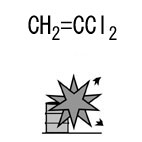| Case Name |
Explosion during taking out used desiccant from a drum can |
| Pictograph |

|
| Date |
April 5, 1995 |
| Place |
Ibaragi prefecture Japan |
| Location |
Chemical factory |
| Overview |
Used desiccant was stored for a long time. Freon, which was a process fluid, was included in the desiccant. The Freon changed to 1, 1-dichloroethylene, and in addition, part of it changed to peroxide. Mixed gas of dichloroethylene and peroxide that was in the explosion range exploded due to the shock of the work. Having left the chemical substance for a long time in the open-air without doing a chemical study was the cause of the accident. |
| Incident |
In an industrial waste outdoor storage at the site of a chemical plant, a drum can containing waste was left for about a half year. Transfer of the waste from the drum can to a tractor shovel started. At that time, an explosion occurred in the drum can, and one person was injured. |
| Processing |
Waste and disposal |
| Substance |
R-141b(Freon), Fig2 |
| 1,1-dichloroethylene, Fig3 |
| Molecular sieve |
| Peroxide |
| Type of Accident |
Explosion |
| Sequence |
1. On September 26th, 1994, a desiccant molecular sieve was drawn out from a dehydrator at the final process in a plant, and put into four drum cans. The drum cans were stored at an industrial waste site in the factory.
2. In April, 1995, a subcontractor was ordered disposal of the desiccant in the drum cans, which had been left for six months, to a sludge disposal site.
3. The subcontractor's employee intended to carry the desiccant in the drum cans by a shovel of a tractor.
4. He started to move the desiccant with a ladle from the 200 L drum can to the shovel.
5. He heard a strange sound from the inside of the second drum can when he started ladling out material from the second drum can. An explosion occurred in the second drum can. |
| Cause |
Among the desiccant in the drum cans, Freon, which is a process fluid, was included. Hydrogen and Fluorine were separated from the Freon during long-term open-air storage, and 1, 1-dichloroethylene was generated. Then peroxide was generated by the reaction of 1, 1-dichloroethylene with the air inside the drum can or with oxygen, which was included in other materials in the drum can. Peroxide and dichloroethylene were in their explosion range, and they exploded due to the impact of the drum can and the metallic ladle. |
| Countermeasures |
1. On disposing of a chemical substance as industrial waste, disposal should be done based on a chemical analysis. The possibility of a chemical change should be studied on the basis of the results, and treatment to remove the hazard should be carried out.
2. A prior study should be carried out in the case of long-term storage, so that dangerous substances should not be generated by a chemical change during storage.
3. Based on the results of a prior study, a waste-handling process, performance standards, etc. should be determined, and made known to all workers thoroughly. |
| Knowledge Comment |
A chemical substance that seems to be very stable in appearance can also undergo chemical change during prolonged storage. It should be kept in mind that prolonged storage without taking precautions is dangerous. |
| Background |
An investigation into the hazards of chemical substances was not conducted, and they were left for a long time. The insufficient management seems to be a basic factor. |
| Reason for Adding to DB |
Example of explosion caused due to chemical change of wastes for long period of storage |
| Scenario |
| Primary Scenario
|
Poor Value Perception, Poor Safety Awareness, Inadequate Risk Recognition, Organizational Problems, Poor Management, Operation Method by Subcontractor's Own Judge, Insufficient Analysis or Research, Insufficient Prior Research, No Consideration of Change in Half Year, Planning and Design, Poor Planning, Poor Storage Planning, Usage, Disposal, Bad Event, Chemical Phenomenon, Abnormal Reaction, Secondary Damage, External Damage, Explosion, Bodily Harm, Injury
|
|
| Sources |
Japan Industrial Safety and Health Assoc. Safety and health information center, Cases of labor accidents, No.1058 A drum can suddenly exploded when it contacted spent desiccant being removed from a drum can by a ladle. The Japan Industrial Safety and Health Assoc. home page
Japan Industrial Safety and Health Assoc. Details of the accident situation.
|
| Number of Injuries |
1 |
| Multimedia Files |
Fig2.Chemical formula
|
|
Fig3.Chemical formula
|
| Field |
Chemicals and Plants
|
| Author |
KOBAYASHI, Mitsuo (Office K)
TAMURA, Masamitsu (Center for Risk Management and Safety Sciences, Yokohama National University)
|
|